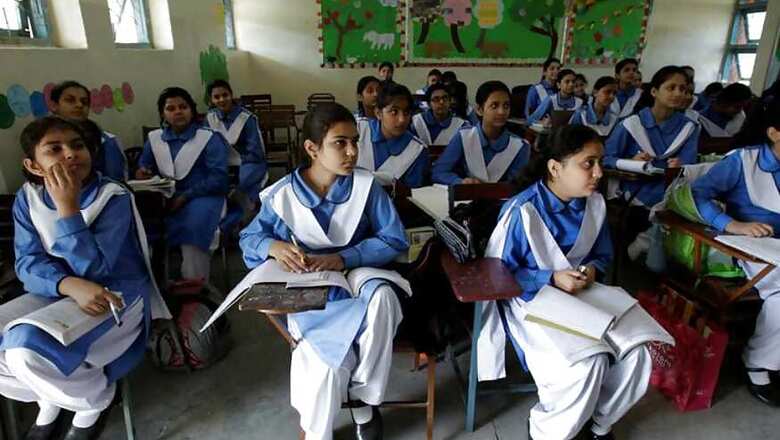
views
New Delhi: The draft New Education Policy (NEP), 2019, has recommended the restructuring of the school curriculum and pedagogy in a new “5+3+3+4 design”.
This is a major departure from the legacies of the National Policy on Education, 1968, which follows the “10+2” format in the school education system.
The NEP committee, headed by former ISRO chief K Kasturirangan, is of the opinion that “while the 10+2 system of school education has served the country well over the past 50 years - and has been an important step forward in uniformising the school education structure in India, modern times and needs with respect to employment and beyond, together with advances and discoveries in cognitive science, have also made clear that a new structure for the educational system is required.”
The reconfiguration has been proposed “to deliver the vision of education enunciated in this policy and to prepare our students optimally in the 21st Century.”
The 10+2 system has been referred in different parts of the country as grades/classes 1-12, with classes 1-5 the primary stage, classes 6-8 the upper primary stage, classes 9-10 the secondary stage and classes 11-12 the higher secondary, pre-university, intermediate or junior college stage.
But now the notions of “higher secondary” or “junior college” will be eliminated. Classes 11 and 12 will be considered an integral part of the secondary stage.
In this design, the focus at all stages will be to “heavily incorporate Indian and local traditions, as well as ethical reasoning, socio-emotional learning, quantitative and logical reasoning, computational thinking and digital literacy, scientific temper, languages and communication skills, in a manner that is developmentally appropriate and in the curricular/pedagogical style that is optimal for each stage,” said the draft.
The committee has also recommended a “system of modular board examinations - restructured to test only core concepts, principles, critical thinking and other higher-order skills in each subject” that will “pin down the common courses, while great flexibility will be offered for remaining courses.”
The draft policy also said the curricular and pedagogical structure of school education will be reconfigured in a way that’ll make it responsive and relevant to the developmental needs and interests of learners at different stages of their development, corresponding to the ages of 3-8 years, 8-11 years, 11-14 years, and 14-18 years, respectively.
The structure and framework for school education will therefore be guided by a 5+3+3+4 design.
Under this, there’ll be five years of the foundational stage that’ll include three years of pre-primary school and grades 1 and 2, followed by three years of the preparatory (or latter primary) stage — grades 3, 4 and 5.
Then, there would be three years of middle (or upper primary) stage — grades 6, 7 and 8 and finally, four years of the high (or secondary) stage — grades 9, 10, 11 and 12.
According to the draft, the “foundational stage will comprise five years of flexible, multilevel, play-based, activity-based, and discovery-based learning, continuously incorporating the latest research in ECCE (Early Childhood Care and Education) as well as the various time-tested Indian traditions for cognitive and emotional stimulation of children.”
The preparatory stage, “will comprise three years of education, building on the play, discovery, and activity-based pedagogical and curricular style of the foundational stage, but also gradually beginning to incorporate textbooks as well as aspects of more formal classroom learning.”
The committee has said that there should mostly be generalist teachers during this stage, with the possible exception of some specialist language and art teachers (who may be shared across the school or school complex).
The aim of this stage will be to lay the general groundwork across subjects, including reading, writing, speaking, physical education, art, languages, science, and mathematics, so that students are prepared to delve deeper into learning areas through specialised subjects and subject teachers in the stages that follow.
The middle stage “will comprise three years of education, building on the more formal pedagogical and curricular style of the elementary stage, but will see the introduction of subject teachers for learning/discussion of the more abstract concepts in each subject that students will be ready for at this stage across the sciences, mathematics, arts, social sciences, and humanities.”
The focus would also be on, “experiential learning within each subject, and explorations of relations among different subjects, will be encouraged and emphasised despite the introduction of more specialised subjects and subject teachers.”
The secondary stage “will comprise four years of multidisciplinary study, and will build on the subject-oriented pedagogical and curricular style of the middle stage, but with greater depth, greater critical thinking, greater attention to life aspirations, and greater flexibility and student choice.”
Semesters at various stages
Each year of the secondary stage will be divided into two semesters, for a total of eight semesters. Each student would take five to six subjects each semester, according to the NEP draft.
“There will be some essential common subjects for all, while simultaneously there will be a great flexibility in selecting elective courses (including in the arts, vocational subjects, and physical education) that all students can expand their horizons as they see fit and explore their individual interests and talents.”
The focus, the draft policy said, would be on “interactive and fun classrooms, where questions are encouraged, with creative, collaborative, and exploratory activities for deeper and more experiential learning.”


















Comments
0 comment